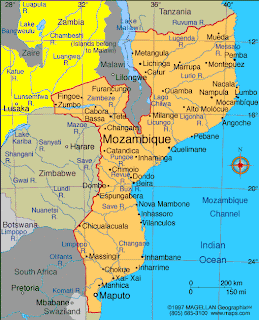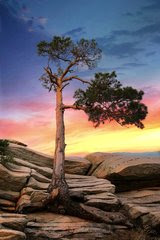Tuesday, March 31, 2009
Mozambique, after independence
Monday, March 30, 2009
Mozambique, War of independence
The Mozambican War of Independence was an armed conflictbetween the guerrilla forces of the FRELIMO and Portuguese forces.The FRELIMO initiated a guerrilla campaign aginst Portuguese rule in Sept. 1964.This conflict along the two other Portuguese colony Angola nd Guinea- Bissau became part of the Portuguese colonial war(1961-1974). From a military standpoint, Portuguese regular armymaintained contrl of the populationcentres while the guerrilla forces sought to undermine their influence in rural and tribal areas in the north and the west.
After 10 years of sporadic warfare and Portugal's return to democracy through a leftist military coup in Lisbon which which replaced Portugal's Estado Novo regimeand gave independence to FRELOMO. Within a year , about 2,50,000 portuguese in Mozambique left for Portugal.
Sunday, March 29, 2009
Mozambique, History (continued)

Mozambique, history

Mozamique's first inhabitants wereSan hunters and gatterers, ancestors of the Khoisani peoples. Between first and fourth century AD waves of Bantu speaking peoples migrated from the north through the Zamberi river valley and then gradually into the plateau and coasal areas in the first millennium.The Bantu were farmers and ironworkers.
Thereafter Arab and Swahili traders settled the region. It was explored by Vasco da Gama in 1498 and Mozambique was first colonized by portugalin 1505. By 1510 the Portuguese conrolled all the former Arab Sulltanates on the east Africancoast. Portuguese colonial rule was repressive.

The island of Mozambique is a small coral island at the mouth of Mossuril Bay on the Nacala coast of northern Mozambique, first explored by Europeans in the late 1400s. The portuguese trading postsand forts became regular ports of call on the new route to the east .Later, traders and prospectors penetrated the interior regions seeking gold and slaves.Portuguese influence gradually expanded through the individual settlers having extesive autonomy. As a result , investment logged while Lisbon devoteditself to the more lucrative trade with India and the far east and to the colonisation of Brazil.
Saturday, March 28, 2009
Mozambique, Intrduction
Mazambique in Africa
Friday, March 27, 2009
Thursday, March 26, 2009
Niger, Economics and politics
Economy
Niger is one of the poorest countries in the world,ranking last on the United Nations Human Development Index,Niger's economy is largely based on subsistence crops,livestock and some of the world largest uranium deposits.
Niger's agricultural and livestock sectors are the main stay of all but 20% of the population. 14% of Niger's gdp is generated by livestock prouction - camels, goats, sheep,and cattle- said to support 29% of the population. 15% of the niger's land is arablewhich is along its southern border with Nigeria.
Hduman development index gives a more complete picture than income.
Human Property in Niger: focussing on most deprived in multiple dimensions of poverty.
Niger's human development index 2005
HDI value ....Life expectancy at birth....Adult illeteracy....gdp per capita
174-.374...........146/55.1..................136/28.7...............178/781
Tuesday, March 24, 2009
Niger, after independence
For the first 14 years, niger was run by a single party civilian regime under the presidency of Hamami Diori.

President Hamami Diori and visiting german presient Dr. Heinrich Lubke greet crowds on a state visit to Niamey ,1960. Diori's single party rule was characterised by goo relations with the west an a preoccupationwith foreign affairs.
In 1974, a combination of devastating drought and accusationsof rampant corruption resulted in a coup d'tat that overthrew the Diori regime. Col. Seyni Kountche and a small military group ruled the country until Kountch's death in 1987. He was succeeded by his Chief of Staff, Col. Ali Saibou,who some bold steps. He released all political prisoners, liberized some Niger's laws and policies and promulgamated a new constitution. But that was the Second Republic with the constitution of single party rule. It also failed due to the demand by students and youths union. As a result another new constitution came up after discussion and conferences. A transition Government under the leadership of Prof. Andre Saliou, was installed as caretaker Govt. in April 1993, as Third Republic.
At this time freedom of the press flourished with the appearence of several new independent news papers.
The jan. 1995 parliament election ended in rivalries between two parties and Col.Ibrahim Bare over throw the third republic in Jan. 1996 installing another (last) military rule.An attempt was made to draft a new constitution and his party won 57% of seats in Parliament to form the fifth Republic in April 1999.

Mamadou Tandja, President of the Republic of Niger.
Sunday, March 22, 2009
Niger, Pre-independence Period
Saturday, March 21, 2009
Niger, map
Niger is slightly greater in area than that of the South Africa but its population is slightly less than that of Delhi whose area is almost thousand times less than that of the Niger. Officially it is known as the Republic of Niger. It is a landlocked country, after the name of the Niger River which flows south-west end of the country and is the only river with its trajectories. its GDP (PPP) per capita, est.2007, is $312i.e. less than 1$ per day. To the south there are Nigeria and Benin, to the west Burkina Faso and Mali,to the north Algeria and Libyaand to the east is chad. It is the largest nation in the west of Africa. Niger is one of the poorest and least developed country in the Worldfor 80% of its territory is covered by desert and the rest is threatened by drought anfd desertification. Niger remains handicapped by its landlocked position, poor education,poor infrustructure, poor health care,and environmental degradation.
After independence Nigerians lived under 5 constitutions, and 3 periods of military rule.
Friday, March 20, 2009
Eritrea, colonialism (continued)
Thursday, March 19, 2009
Eritrea, Colonisation (contd)
Eritrea, colonisation
Tuesday, March 17, 2009
Eritrea, History
Saturday, March 14, 2009
Eritrea, Introduction
Thursday, March 12, 2009
Tajikistan, Economy
Tajikistan, post independence

Wednesday, March 11, 2009
Tajikistan, Post Soviet Era
The post-Soviet era:











































